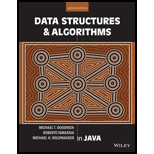
Data Structures and Algorithms in Java
6th Edition
ISBN: 9781118771334
Author: Michael T. Goodrich
Publisher: WILEY
expand_more
expand_more
format_list_bulleted
Expert Solution & Answer
Chapter 3, Problem 16R
Explanation of Solution
Method equals() in Doubly linked list:
// Define the equals() method
public boolean equals(Object list)
{
// Check whether instance of node is not equal
if(!(list instanceof Node))
{
// Return false
return false;
}
// Create another list from "list"
Node<E> otherList = (Node<E>) list;
// Check whether "element" is equal to null
if(element == null)
{
/* Check another list element is equal to null. If yes, return true. Otherwise, return false */
return otherList...
Expert Solution & Answer
Want to see the full answer?
Check out a sample textbook solution
Students have asked these similar questions
Create a relationship between the common field (Technician Number) of the two tables. Make sure that each client must have 1 and only 1 technician assigned, and each technician can have multiple clients.
2. Create a query to show the Client Number, Client Name, Billed, Paid for clients in Anderson city. Save the query.
3. Create a query to show the Technician Number, Last Name, First Name, YTD Earnings for technicians whose Hourly Rate is greater than or equal to 30. Save the query.
4. Create a query to show Client Number, Client Name, Billed, Paid for clients whose technician number is 22 and whose Billed is over 300. Save the query.
5. Create a query to show the Technician Number, Last Name, First Name, Client Number, Client Name for clients whose technician number 23. Save the query.
6. Create a query to show the Technician Number, Last Name, First Name, Client Number, Client Name for clients whose technician number 23 or 29. Save the query Help please Microsoft office access
Dijkstra's Algorithm (part 1). Consider the network shown below, and Dijkstra’s link-state algorithm. Here, we are interested in computing the least cost path from node E (note: the start node here is E) to all other nodes using Dijkstra's algorithm. Using the algorithm statement used in the textbook and its visual representation, complete the "Step 0" row in the table below showing the link state algorithm’s execution by matching the table entries (i), (ii), (iii), and (iv) with their values. Write down your final [correct] answer, as you‘ll need it for the next question.
4. |z + 5 - 5i| = 7
Chapter 3 Solutions
Data Structures and Algorithms in Java
Ch. 3 - Prob. 1RCh. 3 - Write a Java method that repeatedly selects and...Ch. 3 - Prob. 3RCh. 3 - The TicTacToe class of Code Fragments 3.9 and 3.10...Ch. 3 - Prob. 5RCh. 3 - Prob. 6RCh. 3 - Prob. 7RCh. 3 - Prob. 8RCh. 3 - Prob. 9RCh. 3 - Prob. 10R
Ch. 3 - Prob. 11RCh. 3 - Prob. 12RCh. 3 - Prob. 13RCh. 3 - Prob. 14RCh. 3 - Prob. 15RCh. 3 - Prob. 16RCh. 3 - Prob. 17CCh. 3 - Prob. 18CCh. 3 - Prob. 19CCh. 3 - Give examples of values for a and b in the...Ch. 3 - Suppose you are given an array, A, containing 100...Ch. 3 - Write a method, shuffle(A), that rearranges the...Ch. 3 - Suppose you are designing a multiplayer game that...Ch. 3 - Write a Java method that takes two...Ch. 3 - Prob. 25CCh. 3 - Prob. 26CCh. 3 - Prob. 27CCh. 3 - Prob. 28CCh. 3 - Prob. 29CCh. 3 - Prob. 30CCh. 3 - Prob. 31CCh. 3 - Prob. 32CCh. 3 - Prob. 33CCh. 3 - Prob. 34CCh. 3 - Prob. 35CCh. 3 - Write a Java program for a matrix class that can...Ch. 3 - Write a class that maintains the top ten scores...Ch. 3 - Prob. 38PCh. 3 - Write a program that can perform the Caesar cipher...Ch. 3 - Prob. 40PCh. 3 - Prob. 41PCh. 3 - Prob. 42PCh. 3 - Prob. 43P
Knowledge Booster
Similar questions
arrow_back_ios
SEE MORE QUESTIONS
arrow_forward_ios
Recommended textbooks for you
 C++ Programming: From Problem Analysis to Program...Computer ScienceISBN:9781337102087Author:D. S. MalikPublisher:Cengage Learning
C++ Programming: From Problem Analysis to Program...Computer ScienceISBN:9781337102087Author:D. S. MalikPublisher:Cengage Learning EBK JAVA PROGRAMMINGComputer ScienceISBN:9781337671385Author:FARRELLPublisher:CENGAGE LEARNING - CONSIGNMENT
EBK JAVA PROGRAMMINGComputer ScienceISBN:9781337671385Author:FARRELLPublisher:CENGAGE LEARNING - CONSIGNMENT New Perspectives on HTML5, CSS3, and JavaScriptComputer ScienceISBN:9781305503922Author:Patrick M. CareyPublisher:Cengage Learning
New Perspectives on HTML5, CSS3, and JavaScriptComputer ScienceISBN:9781305503922Author:Patrick M. CareyPublisher:Cengage Learning Microsoft Visual C#Computer ScienceISBN:9781337102100Author:Joyce, Farrell.Publisher:Cengage Learning,COMPREHENSIVE MICROSOFT OFFICE 365 EXCEComputer ScienceISBN:9780357392676Author:FREUND, StevenPublisher:CENGAGE LNp Ms Office 365/Excel 2016 I NtermedComputer ScienceISBN:9781337508841Author:CareyPublisher:Cengage
Microsoft Visual C#Computer ScienceISBN:9781337102100Author:Joyce, Farrell.Publisher:Cengage Learning,COMPREHENSIVE MICROSOFT OFFICE 365 EXCEComputer ScienceISBN:9780357392676Author:FREUND, StevenPublisher:CENGAGE LNp Ms Office 365/Excel 2016 I NtermedComputer ScienceISBN:9781337508841Author:CareyPublisher:Cengage

C++ Programming: From Problem Analysis to Program...
Computer Science
ISBN:9781337102087
Author:D. S. Malik
Publisher:Cengage Learning

EBK JAVA PROGRAMMING
Computer Science
ISBN:9781337671385
Author:FARRELL
Publisher:CENGAGE LEARNING - CONSIGNMENT

New Perspectives on HTML5, CSS3, and JavaScript
Computer Science
ISBN:9781305503922
Author:Patrick M. Carey
Publisher:Cengage Learning

Microsoft Visual C#
Computer Science
ISBN:9781337102100
Author:Joyce, Farrell.
Publisher:Cengage Learning,

COMPREHENSIVE MICROSOFT OFFICE 365 EXCE
Computer Science
ISBN:9780357392676
Author:FREUND, Steven
Publisher:CENGAGE L

Np Ms Office 365/Excel 2016 I Ntermed
Computer Science
ISBN:9781337508841
Author:Carey
Publisher:Cengage